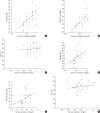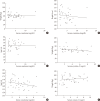Clinical usefulness of serum cystatin C as a marker of renal function
- PMID: 25215274
- PMCID: PMC4160581
- DOI: 10.4093/dmj.2014.38.4.278
Clinical usefulness of serum cystatin C as a marker of renal function
Abstract
Background: Accurate renal function measurements are important in the diagnosis and treatment of kidney diseases. In contrast to creatinine, the production of serum cystatin C has been extensively reported to be unaffected by body muscle mass, age, gender, and nutritional status.
Methods: Our study included 37 samples from diabetic chronic kidney disease (CKD) patients for whom serum creatinine tests had been requested and 40 samples from a healthy populations in Dong-A University Hospital between May 2010 and June 2010. The assay precision (i.e., the coefficient of variation) and the reference range of the serum cystatin C test were evaluated. We compared the estimated glomerular filtration rates (GFRs) based on cystatin C with those based on creatinine. Moreover, we investigated the influences of age, gender, weight, and muscle mass on serum creatinine and serum cystatin C.
Results: There was a positive correlation between GFR based on creatinine and that based on cystatin C (r=0.79, P<0.0001) among the diabetic CKD patients. Serum creatinine and cystatin C were significantly correlated with body weight and muscle mass, but the strengths of these correlations were greater for serum creatinine. The precision study revealed excellent results for both the high and low controls. The 95% reference interval of cystatin C in the healthy population was 0.371 to 1.236 mg/L.
Conclusion: Based on these results, we conclude that, despite the strong correlation between serum creatinine and cystatin C, cystatin C is less affected by weight and muscle mass and might represent a better alternative for the assessment of renal function.
Keywords: Renal function; Serum creatinine; Serum cystatin C.
Conflict of interest statement
No potential conflict of interest relevant to this article was reported.
Figures



Similar articles
-
Rapid and accurate assessment of glomerular filtration rate in patients with renal transplants using serum cystatin C.Nephrol Dial Transplant. 1999 Aug;14(8):1991-6. doi: 10.1093/ndt/14.8.1991. Nephrol Dial Transplant. 1999. PMID: 10462282
-
Cystatin C is a more sensitive marker than creatinine for the estimation of GFR in type 2 diabetic patients.Kidney Int. 2002 Apr;61(4):1453-61. doi: 10.1046/j.1523-1755.2002.00253.x. Kidney Int. 2002. PMID: 11918752
-
Estimating renal function in children: a new GFR-model based on serum cystatin C and body cell mass.Dan Med J. 2012 Jul;59(7):B4486. Dan Med J. 2012. PMID: 22759853 Review.
-
Performance of the estimated glomerular filtration rate creatinine and cystatin C based equations in Thai patients with chronic glomerulonephritis.Int J Nephrol Renovasc Dis. 2015 Oct 21;8:145-50. doi: 10.2147/IJNRD.S93866. eCollection 2015. Int J Nephrol Renovasc Dis. 2015. PMID: 26527894 Free PMC article.
-
[Development of evaluation of kidney function and classification of chronic kidney disease (CKD)--including CKD clinical practice guide 2012].Rinsho Byori. 2013 Jul;61(7):616-21. Rinsho Byori. 2013. PMID: 24205704 Review. Japanese.
Cited by
-
Association between elevated serum REG Iα levels and eGFR decline in patients with chronic kidney disease: a cross-sectional study in eastern China.BMJ Open. 2025 Feb 13;15(2):e086874. doi: 10.1136/bmjopen-2024-086874. BMJ Open. 2025. PMID: 39947821 Free PMC article.
-
Comparison of Carvedilol and Metoprolol for Preventing Contrast-Induced Nephropathy after Coronary Angiography.Cardiorenal Med. 2015 Jun;5(3):199-207. doi: 10.1159/000381964. Epub 2015 May 30. Cardiorenal Med. 2015. PMID: 26195972 Free PMC article.
-
Clinician perspectives on inpatient cystatin C utilization: A qualitative case study at Mayo Clinic.PLoS One. 2020 Dec 11;15(12):e0243618. doi: 10.1371/journal.pone.0243618. eCollection 2020. PLoS One. 2020. PMID: 33306741 Free PMC article.
-
Performance of cystatin C- and creatinine-based estimated glomerular filtration rate equations depends on patient characteristics.Clin Chem. 2015 Oct;61(10):1265-72. doi: 10.1373/clinchem.2015.243030. Epub 2015 Aug 3. Clin Chem. 2015. PMID: 26240296 Free PMC article.
-
Dyslipidemia and serum cystatin C levels as biomarker of diabetic nephropathy in patients with type 2 diabetes mellitus.Front Endocrinol (Lausanne). 2023 Apr 4;14:1124367. doi: 10.3389/fendo.2023.1124367. eCollection 2023. Front Endocrinol (Lausanne). 2023. PMID: 37082121 Free PMC article.
References
-
- Shemesh O, Golbetz H, Kriss JP, Myers BD. Limitations of creatinine as a filtration marker in glomerulopathic patients. Kidney Int. 1985;28:830–838. - PubMed
-
- Bjornsson TD. Use of serum creatinine concentrations to determine renal function. Clin Pharmacokinet. 1979;4:200–222. - PubMed
-
- Levey AS, Bosch JP, Lewis JB, Greene T, Rogers N, Roth D Modification of Diet in Renal Disease Study Group. A more accurate method to estimate glomerular filtration rate from serum creatinine: a new prediction equation. Ann Intern Med. 1999;130:461–470. - PubMed
-
- Gates GF. Creatinine clearance estimation from serum creatinine values: an analysis of three mathematical models of glomerular function. Am J Kidney Dis. 1985;5:199–205. - PubMed
-
- Jelliffe RW, Jelliffe SM. A computer program for estimation of creatinine clearance from unstable serum creatinine levels, age, sex, and weight. Math Biosci. 1972;14:17–24.
LinkOut - more resources
Full Text Sources
Other Literature Sources

